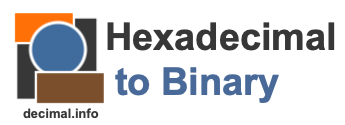
Here we will show you how to convert the hexadecimal number 1F1A to a binary number. First note that the hexadecimal number system has sixteen different digits (0 1 2 3 4 5 6 7 8 9 A B C D E F) and the binary number system has only two different digits (0 and 1).
The four steps used to convert 1F1A from hexadecimal to binary are explained below.
Step 1)
Multiply the last digit in 1F1A by 16⁰, multiply the second to last digit in 1F1A by 16¹, multiply the third to last digit in 1F1A by 16², multiply the fourth to last digit in 1F1A by 16³, and so on, until all the digits are used.
A × 16⁰ = 10
1 × 16¹ = 16
F × 16² = 3840
1 × 16³ = 4096
Remember that the hexadecimal number system has sixteen different digits, so when doing the above calculation, we use the following values if applicable: A=10, B=11, C=12, D=13, E=14, and F=15.
Step 2)
Next, we add up all the products we got from Step 1, like this:
10 + 16 + 3840 + 4096 = 7962
Step 3)
Now we divide the sum from Step 2 by 2. Put the remainder aside. Then divide the whole part by 2 again, and put the remainder aside again. Keep doing this until the whole part is 0.
7962 ÷ 2 = 3981 with 0 remainder
3981 ÷ 2 = 1990 with 1 remainder
1990 ÷ 2 = 995 with 0 remainder
995 ÷ 2 = 497 with 1 remainder
497 ÷ 2 = 248 with 1 remainder
248 ÷ 2 = 124 with 0 remainder
124 ÷ 2 = 62 with 0 remainder
62 ÷ 2 = 31 with 0 remainder
31 ÷ 2 = 15 with 1 remainder
15 ÷ 2 = 7 with 1 remainder
7 ÷ 2 = 3 with 1 remainder
3 ÷ 2 = 1 with 1 remainder
1 ÷ 2 = 0 with 1 remainder
Step 4)
In the final step, we take the remainders from Step 3 and put them together in reverse order to get our answer to 1F1A hexadecimal to binary:
1F1A hexadecimal = 1111100011010 binary
Hexadecimal to Binary Converter
Here you can convert another hexadecimal number to binary.
1F1B hexadecimal to binary
Go here for the next hexadecimal number on our list that we have converted to binary.
Copyright | Privacy Policy | Disclaimer | Contact
